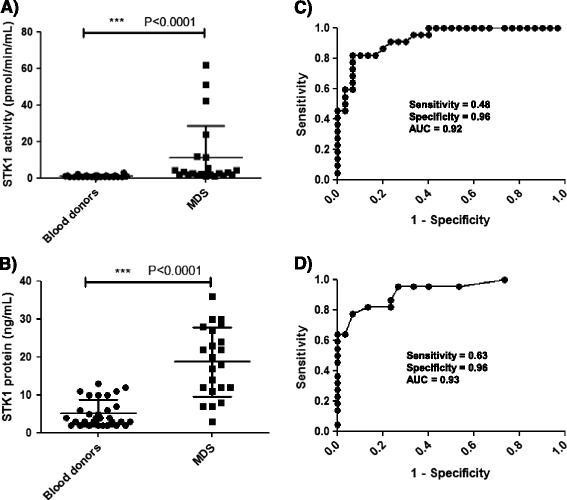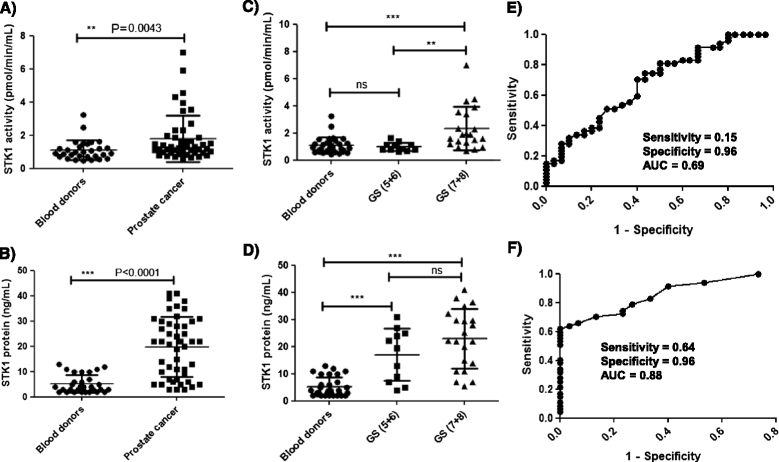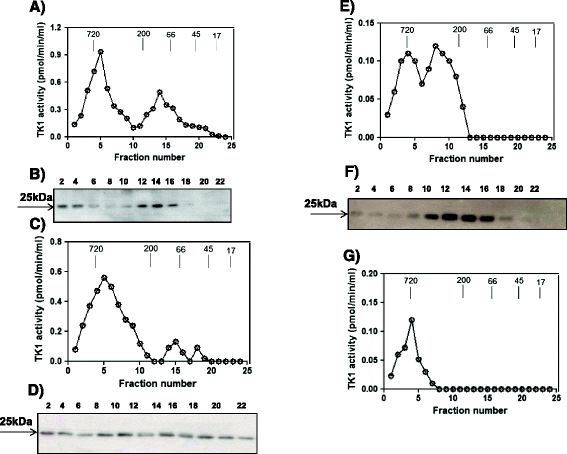Breast and prostate cancer patients differ significantly in their serum Thymidine kinase 1 (TK1) specific activities compared with those hematological malignancies and blood donors: implications of using serum TK1 as a biomarker
- PMID: 25881026
- PMCID: PMC4336758
- DOI: 10.1186/s12885-015-1073-8
Breast and prostate cancer patients differ significantly in their serum Thymidine kinase 1 (TK1) specific activities compared with those hematological malignancies and blood donors: implications of using serum TK1 as a biomarker
Abstract
Background: Thymidine kinase 1 (TK1) is a cellular enzyme involved in DNA precursor synthesis, and its activity has been used as a proliferation marker for monitoring malignant diseases. Here, for the first time, we evaluated both TK1 activity and protein levels in sera from patients with different malignancies.
Methods: Serum samples from patients with myelodysplastic syndrome (MDS, n = 22), breast cancer (n = 42), prostate cancer (n = 47) and blood donors (n = 30) were analyzed for TK1 protein and activity levels, using a serum TK1 (STK1) protein assay based on antibodies and an activity assay that measured [(3)H]-deoxythymidine (dThd) phosphorylation. The molecular forms of TK1 in sera from some of these patients were analyzed using size-exclusion chromatography.
Results: Mean STK1 activities in sera from MDS, breast and prostate cancer were 11 ± 17.5, 6.7 ± 19 and 1.8 ± 1.4 pmol/min/mL, differing significantly from blood donors (mean ± standard deviation (SD) = 1.1 ± 0.9 pmol/min/mL). Serum TK1 protein (25 kDa polypeptide) levels were also significantly higher in MDS, breast, prostate cancer compared to blood donors (mean ± SD = 19 ± 9, 22 ± 11, 20 ± 12, and 5 ± 3.5 ng/mL, respectively). The STK1 specific activities of sera from patients with MDS and blood donors were significantly higher when compared with activities in sera from breast and prostate cancer patients. Size-exclusion analysis of sera from breast and prostate cancer showed that the detected active TK1 was primarily a high molecular weight complex, similar to the forms found in sera from MDS patients and blood donors. However, Western blotting demonstrated high TK1 25 kDa protein levels in fractions lacking TK1 activity in sera from cases with breast and prostate cancer.
Conclusions: These results demonstrate that there are differences in the specific activities and the subunit compositions of STK1 in hematological malignancies compared with breast and prostate cancer. This fact has several important implications for the use of STK1 as a tumor biomarker. One is that STK1 protein assays may differentiate early-stage tumor development in breast and prostate cancer more effectively than STK1 activity assays.
Figures






References
-
- He Q, Fornander T, Johansson H, Johansson U, Hu GZ, Rutqvis LE, et al. Thymidine kinase 1 in serum predicts increased risk of distant or loco-regional recurrence following surgery in patients with early breast cancer. Anti Cancer Res. 2006;26:4753–9. - PubMed
Publication types
MeSH terms
Substances
LinkOut - more resources
Full Text Sources
Other Literature Sources
Medical
Research Materials
Miscellaneous

